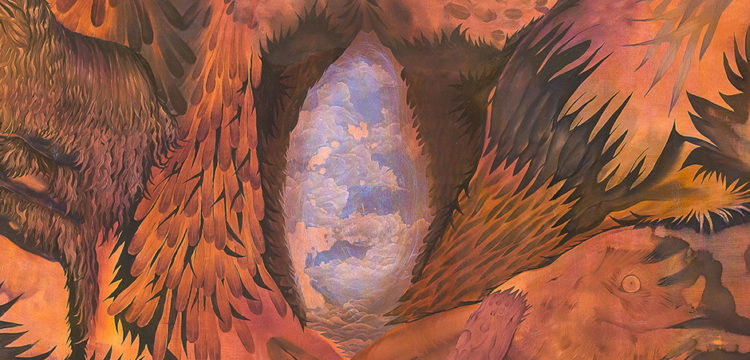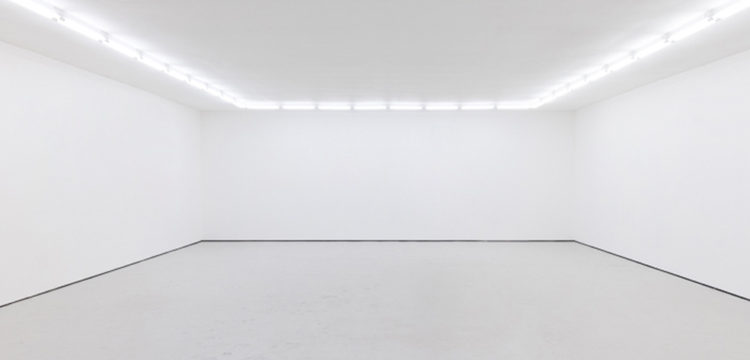On Decay and Theatrical Interiors
Krisztián Török and Thomas Hutton talk about making art in Rome, sunsets and chiaroscuro, touch and allure
Thomas Hutton is on view at Studioli until October 25th, 2018
Krisztián Török: Making work in Rome or exhibiting in Rome must be difficult when there are so many layers of history. It must be hard to find a starting point. What was the starting point of this exhibition?
Thomas Hutton: I think that’s true. When I lived in Rome I would often be working on something only to look out from the studio window and become instantly disheartened. All those layers certainly amass to something very heavy. Ultimately though it was those layers that brought me to Rome in the first place so in a way they were also my starting point. For some years now I’ve been tracing all these spatial conditions, materials and techniques back to Rome and so this exhibition was a chance to revisit them in the place where they originated, where they have a special kind of significance.
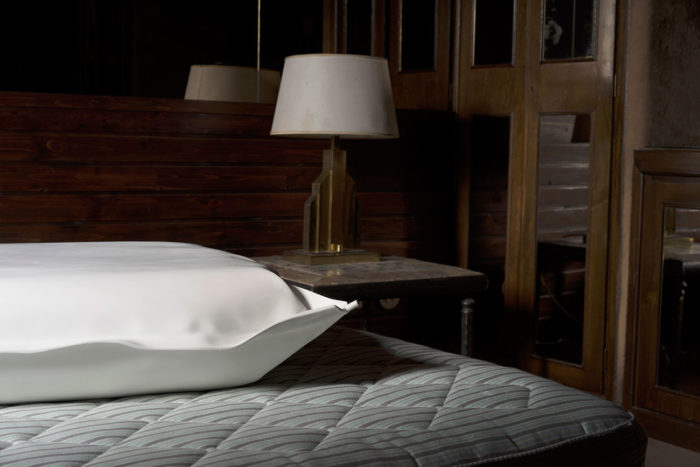
Untitled (inflated), 2018. Calcium carbonate, composite resin, alkyd resin, iron oxide, carbon steel, compressed air
Krisztián Török: The first time I entered the first of the two exhibition rooms I was struck by how the golden light of Rome breathes life into the material of the sculptures. I felt there was a sort of continuity through the light-air-material. Can you tell me more about this relationship?
Thomas Hutton: I thought a lot about how I could shape the atmosphere of the exhibition spaces in order get the most out of the sculptures in Studioli’s rather particular environment. The rooms were built as part of a large garçonnière complex for sexual rendezvous and the like. They would have been mainly used under the cover of darkness so I thought about opening them up for a particular time of the day—the two hours before the sun sets when the light is visibly fading with every moment. As winter sets in there’s already a strong sense of light fading. Consistent artificial light tends to lift things out of time, suspending them, deadening them even; by placing them in a moving light I supposed they could be animated. As the light fades, the information in the sculptures’ surface dissolves with it and they become increasingly difficult to read. So they’re kind of veiled in dying light. But the material doesn’t sit still either; your estimation of it is constantly shifting. It looks like stone or porcelain or paper or leather; it’s covered with stucco but stucco dries with the air into limestone; the structure below is steel but then also air which is constantly trying to oxidize the steel.
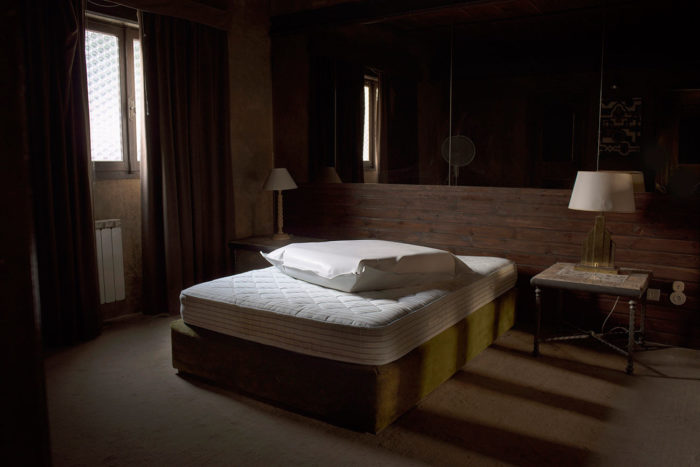
Untitled (inflated), 2018. Calcium carbonate, composite resin, alkyd resin, iron oxide, carbon steel, compressed air
Krisztián Török: So during the course of the exhibition there is only the possibility of decay?
Thomas Hutton: Perhaps the exhibition is kind of morbid or graven in that way. When I found the original steel pillows at the bottom of the quarry they were already very rusted, the air was degrading them very rapidly. It was really like they were dead. I stabilized the oxidization and sealed the outer skin before eventually entombing them in the plaster but perhaps they are still rusting from the inside? Who knows?! In the British Museum in London there’s this Assyrian palm trunk decorated with lots of triangles of mother of pearl and limestone segments, all arranged to look the diamond-like pattern of palm frond scars. The segments are set into a thick layer of bitumen that was applied thickly all over the trunk of an actual date palm tree. So an actual palm tree becomes the armature for a surface decoration that is an abstract representation of what lies beneath. The strange thing is that I would have always assumed that the bitumen would have preserved the palm trunk beneath but apparently it has long since rotted away and only the exterior is left.
Krisztián Török: How does the material list contribute to the sculptures’ ambiguity?
Thomas Hutton: Material lists can often be confusing. Ultimately you can only actually see the surface material of these sculptures and even that is polished to a point where it’s hard to determine. The list is a way to perpetuate that I think, though at the same time to reveal everything. “Compressed air” is even listed, which could obviously never be seen!
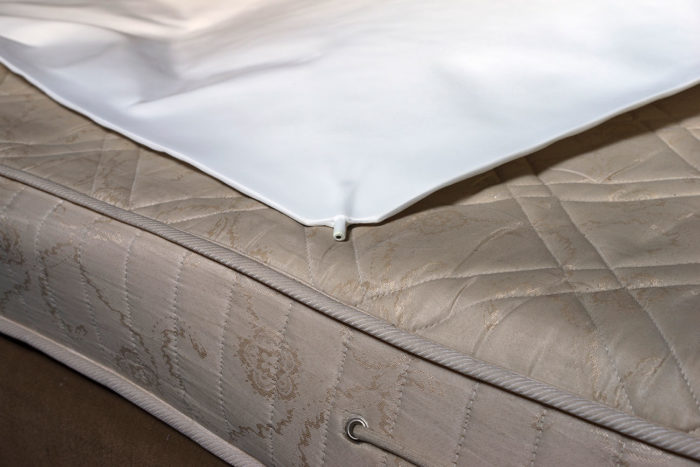
Untitled (collapsed). 2018, Calcium carbonate, composite resin, alkyd resin, iron oxide, carbon steel, compressed air
Krisztián Török: So compressed air becomes one of the materials; it becomes part of the work.
Thomas Hutton: In a way I think it’s their armature. Their sculptural form is determined by the compressed air they’re filled with. This air sculpted them. It’s also air that transforms the calcium hydroxide (the plaster) applied to the surface back into calcium carbonate (limestone). Then I even ended up installing an electric fan in each room to gently blow air over their surface and keep the dust off. I was thinking a lot about the potential for a kind of cyclical energy.
Krisztián Török: But in the case of the pillows there is a back and forth motion like breath?
Thomas Hutton: Yes in a sense the pillows breathe. One is ‘inflated’ the other ‘collapsed’ like a lung expanding and contracting in breath. I tried to reinforce these differences in form and feeling with the way they were made. So with the inflated pillow I brushed on the stucco in multiple layers to preserve a kind of lightness whereas with the collapsed one I trowelled it on, compressing the plaster with each layer. As the two spaces are directly on top of one another I installed the collapsed pillow in the downstairs space below the inflated one. The bed in the downstairs space is also slightly sunken into the room with two steps your viewing position is much higher that with the inflated pillow. So even your eyes end up compressing it down onto the mattress.
Krisztián Török: Thinking about the experience of looking at them, the sculptures seem to invite you in close and that’s when you know they’re not what they seem.
Thomas Hutton: The day after the opening I had to polish all the fingerprints out of the surface!
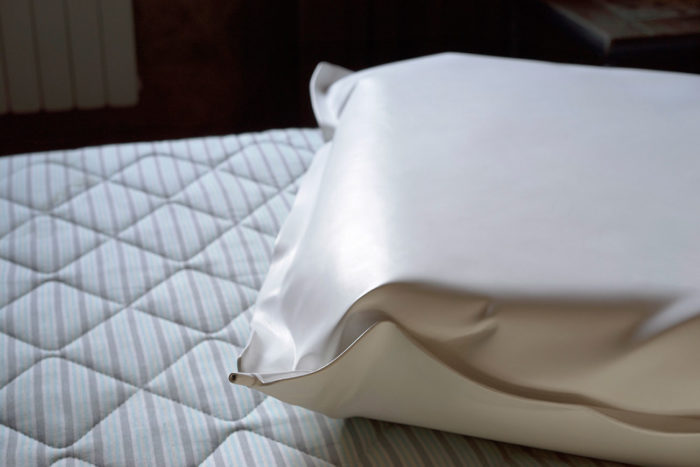
Untitled (inflated). 2018, Calcium carbonate, composite resin, alkyd resin, iron oxide, carbon steel, compressed air
Krisztián Török: That makes me think about the Venus sculpture that was so lifelike that people tried to make love with it. How can a stone object to be so alluring?
Thomas Hutton: We tend to like shiny smooth things, they’re seductive, they lure us into touching them. Apple realized this didn’t they?! Most of all though it’s the ambiguity I think that seduces us. If something is veiled it is more intriguing than something revealed. It holds our interest. The pillows’ material is hard to read. It’s difficult to know whether they’re soft or hard, solid or hollow, cast or carved. Their material restlessness makes them difficult to work out and perhaps by nature we want to be able to understand things, know what they’re made of. The stone material of the Venus is defied by the form of the sculpture. So the brain tells you one thing and the eye tells you another. They defy your material expectations so you end up caught in between, quivering between conflicting information. I think this is what was called thauma, or ‘wonder,’ in Ancient Greek. It’s a two-foldedness that doesn’t allow something to sit still, it sustains a kind of movement that evokes wonder. But even when we think we know what something is made of, we only ever see the surface which is a façade. We look closely to understand more; we look under a microscope, through a subatomic microscope—the closest kind of inspection—and material just dissolves into abstraction. Wave-particle duality?! I mean c’mon, what is that?! Material is made of waves and particles at once?! It’s such an abstract conception of material that is so far from what we hold in our hands or see with our eyes. Touching is one way to know or to understand, but maybe it’s nicer sometimes to wonder.
Krisztián Török: That’s the endless question isn’t it?! You think you can understand something but you only ever get to another element.
Thomas Hutton: I think so. It’s one of the reasons the text I wrote for the exhibition is cyclical; it ends where it begins. It often seems like we’re just running around in circles.
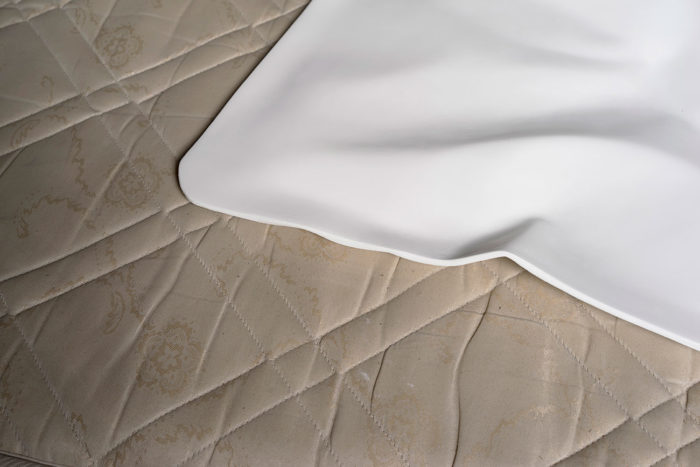
Untitled (collapsed). 2018, Calcium carbonate, composite resin, alkyd resin, iron oxide, carbon steel, compressed air
Krisztián Török: The script from the tour you did in Rome Zoo in 2015 and the lecture at MoCA earlier this year were also cyclical.
Thomas Hutton: Yes in the zoo I literally led people round the interior perimeter of the original part of Hagenbeck’s zoo so we physically ended where we started. Drawing circles rather than lines helps set up a space rather than a route.
Krisztián Török: Creating boundaries.
Thomas Hutton: It sets up a kind of wall and within that a space is defined where you can put ideas. In the case of the zoo any conceptual boundary was reinforced by the actual boundary of the zoo which as you can imagine is quite important in a zoo!
Krisztián Török: Did you think about any boundaries existing between the two Studioli rooms?
Thomas Hutton: Well the rooms aren’t physically connected, there’s a hallway and staircase between them with a couple of other locked doors on each of the two floors. So when you move from one room to the other you are in an in-between space, a kind of pause. Because the objects aren’t adjacent and so you can’t compare their differences directly, the space between them can be a moment to recall what you’ve just seen and anticipate what you’re about to see. I tried to treat the rooms differently to give them different feelings, so they didn’t feel monotonous but instead like two sides of a coin. So for example the mattress in one room was golden and warm and in the other it was blue and cold.
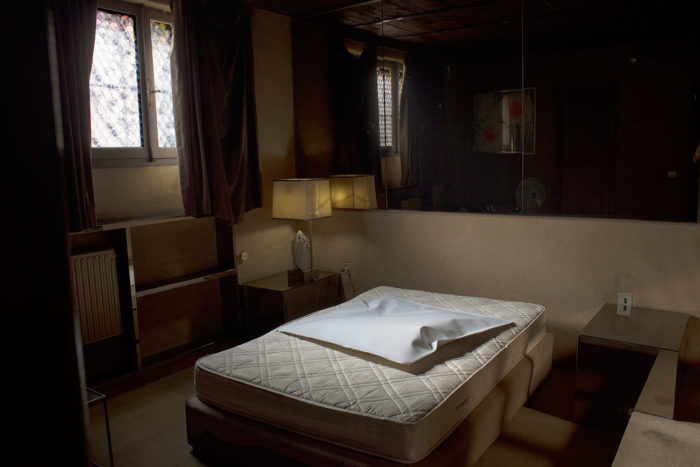
Untitled (collapsed). 2018, Calcium carbonate, composite resin, alkyd resin, iron oxide, carbon steel, compressed air
Krisztián Török: The other difference I noticed was that in the lower one the pillow’s mouthpiece is hidden in shadow whereas above the inflated pillow is turned on the bed so the mouthpiece points towards you when you enter the room.
Thomas Hutton: Yes the mouthpiece of the inflated pillow looks at you as you enter the room, like an eye. It’s the only opportunity to glimpse through the surface into the sculpture’s interior. A bit like the hollow eyes of Greek bronze statues. In the Palazzo Massimo there’s an incredible photograph of the Boxer at Rest being excavated from an enormous depth. But when he emerged his carved stone eyes were gone and instead two deep black voids that reveal the sculpture as being hollow. I actually think I prefer it without the solid eyes because the hollowness of the eyes is somehow at odds with the solidity of the sculpture, that tension is more apparent than if you only were only able to presume it to be. I felt like the small black hole of the mouthpiece functioned the same way.
Krisztián Török: How much you see your pillows in relation to the history of sculpture; in particular, I was thinking about the tradition of carving stone to appear like something soft? For example, the drapery of a Greek statue, the pillows of medieval tombs, or the skin of Bernini’s Apollo and Daphne.
Thomas Hutton: I was kind of toying with this tradition. On the one hand the pillow was a popular motif in funerary sculpture because of its obvious connotations with sleep and so death. But on the other hand it also allowed a sculptor of stone to push the limits of their material. By capturing something soft in an inherently hard material, the stone gets to transcend its materiality to give the sculpture that vibrating energy I was talking about before. Obviously my pillows aren’t carved stone. They’re made from the steel pillows used in the travertine quarries in Tivoli to separate the cut blocks from the quarry wall. So in a sense, stone becomes the subject matter more than the material, so the tradition of you’re talking about is kind of inverted.
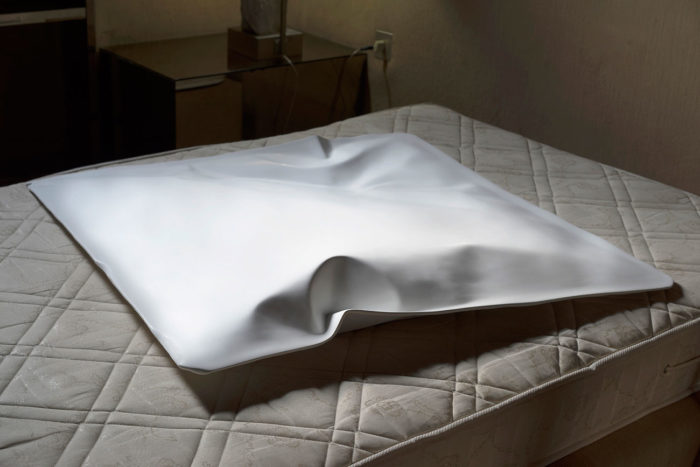
Untitled (collapsed). 2018, Calcium carbonate, composite resin, alkyd resin, iron oxide, carbon steel, compressed air
Krisztián Török: It seems like Studioli is also part of the tradition of theatrical interiors in Rome. The first time we met we talked about this history briefly. How did the pre-existing condition of the interior affect your process?
Thomas Hutton: Certainly the site informed every aspect of the process of their installation but the sculptures themselves were conceived of completely independently of the Studioli spaces and aren’t site-specific. I looked at quite a few of the Studioli spaces. The two I ultimately decided on really stood out from the others. Maybe because in both of them the beds felt like clear focal points. Particularly the lower one with the bed sunken into the ground. When you enter the room you have this really intense view from above down over the bed. It felt like a kind of stage and the stitched grid of the mattress structure bathed in natural light seemed like the perfect kind of pedestal. This was really the starting point for deciding what I would show in the spaces. Then at the same time I kept thinking about the intensity of their natural chiaroscuro. Big areas of dark space where the furnishings fade but the mattress emerges out of them, glowing, like the way that flesh emerges from the black expanse of a Caravaggio. In fact it all really began to click when at some point I began thinking of the two pillows in relation to how the skull and the head work with each other in St Jerome Writing. As your eyes cycle between the two you understand that they’re almost the same object, only separated by the thinnest surface of skin that is almost translucent. But that slightest of surfaces becomes the difference between life and death.
Krisztián Török: This process brings us back to another cycle! So in a way the exhibition was also being conceived of as an image! What role does the documentation play in the work?
Thomas Hutton: The documentation is really just that, documentation. Their only real purpose is to record the exhibition as accurately as possible. But because the Studioli space is so distinctive its relationship to the sculptures installed became as important to the exhibition as the sculptures themselves. So I adjusted the curtains, polished the mirrors, placed the lamps, even removed some pieces of furniture, all to try and shape the atmosphere and set the scene. But still I was always thinking about that scene in three dimensions and considering how it would be experienced, never how it would eventually be photographed. I’m much more interested in how theatrical space seems to actors who exist in it rather than to the audience who only get to look on from a distance.
Krisztián Török: From the position of the audience you can’t really know what is false or what is real. Rome is like that isn’t it?!
Thomas Hutton: I used to think of all the contemporary built world as a kind of theatre of endless facades and surfaces. I tended to think of it as sinister or scary; like when somebody has one expression on their face but they’re really thinking something else on the inside. I thought about it as a kind of acting, something theatrical and always traced it back to Rome where plaster walls are painted to look like stone or where travertine facades conceal the brick structure behind. But there’s nothing really all that sinister about the theatrical space of Rome. In fact you tend to always know exactly what’s “false” or what’s “real.” The wall paintings don’t actually look like stone, they look like paintings of stone; and if you walk round the side or back of a church you can see it’s all made of brick. There’s actually a certain honesty in it and so it remains playful, funny even. In fact that’s maybe even what makes it theatrical rather than devious. When you go to the theatre you don’t actually believe what you’re seeing is real; you know that you’re in a theatre, but you suspend your disbelief.


